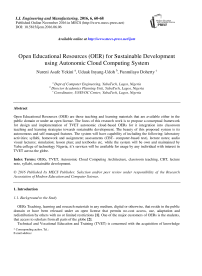Open Educational Resources (OER) for Sustainable Development using Autonomic Cloud Computing System
Автор: Nureni Asafe Yekini, Uduak Inyang-Udoh, Funmilayo Doherty
Журнал: International Journal of Engineering and Manufacturing(IJEM) @ijem
Статья в выпуске: 6 vol.6, 2016 года.
Бесплатный доступ
Open Educational Resources (OER) are those teaching and learning materials that are available either in the public domain or under an open license. The focus of this research work is to propose a conceptual framework for design and implementation of TVET autonomic cloud-based OERs for it integration into classroom teaching and learning strategies towards sustainable development. The beauty of this proposed system is its autonomous and self-managed features. The system will have capability of including the following: laboratory activities; syllabi, homework and assignment; assessments (CBT- computer-based test), lecture notes; audio visual lectures; simulation; lesson plan; and textbooks etc. while the system will be own and maintained by Yaba college of technology Nigeria, it's services will be available for usage by any individual with interest in TVET across the globe.
OERs, TVET, Autonomic Cloud Computing Architecture, classroom teaching, CBT, lecture note, syllabi, sustainable development
Короткий адрес: https://sciup.org/15014422
IDR: 15014422
Список литературы Open Educational Resources (OER) for Sustainable Development using Autonomic Cloud Computing System
- UNESCO (2015): Open Educational Resources. What+is+TVET. Retrieved from http:// www.unesco.org/communication-and-information/access-to-knowledge/open-education-resources Accessed: 18/02/16
- Silvertown, J. (2009). A new dawn for citizen science. Trends in Ecology & Evolution (Personal edition), 24(9), 467-471. Retrieved from http://linkinghub.elsevier.com/retrieve/pii/S016953470900175X
- Khalid A. (2009): Survey of Frameworks, Architectures and Techniques in Autonomic Computing," in Autonomic and Autonomous Systems, 2009. ICAS '09. Fifth International Conference, vol., no., pp.220-225, 20-25 April 2009 doi: 10.1109/ICAS.2009.38
- Fortes J. (2012): director of the US National Science Foundation's Center for Autonomic Computing. Image courtesy José Fortes. https://sciencenode.org/feature/what-autonomic-computing.php
- McGreal R. (2013): The Need for Open Educational Resources. Commonwealth of Learning Prospective on open and distance learning 2013.
- Doherty V.F. (2016): understanding open education resources (OER) Yaba College of Technology UNEVOC Centre for Research and Sustainable Development.
- Anderson T. (2013): Open Access Scholarly Publications as OER. International review of research in open and distributed learning. Advancing research, theory, and practice in open distributed learning worldwide Athabasca University, Canada.
- Highton M., Fresen J, & Wild J. (n.d): Making Academic OER Easy: Reflections on Technology and Openness at Oxford University. Journal of open, flexible and distance learning.
- Bradshaw P, Younie S, & Jones S. (2012). The Use of Open Education Resources in Higher Education Programmes of Academic Practice. ICICTE 2012 Proceedings.
- Roberston R. (2010): What do academic libraries have to do with Open Educational Resources? Theme: Long term sustainability of open education projects. In Open Ed 2010 Proceedings. Barcelona: UOC, OU, BYU. [Accessed: 13/01/16].http://hdl.handle.net/10609/4847
- Browne T, Holding R, Howell A, Rodway-Dyer S, (2010). The challenges of OER to Academic Practice. Journal of interactive media in education Volume: 2010, ISSUE: 1.
- Oludipe O., Fatoki O. K., Yekini N. A., & Aigbokhan E. E. "Cloud-Based E-Learning Platform: From the Perspective of 'Structure' and 'Interaction" International Journal of Innovation and Research in Educational Sciences. Volume 1, Issue 1.


